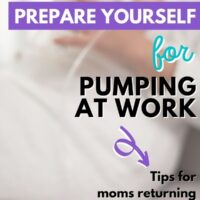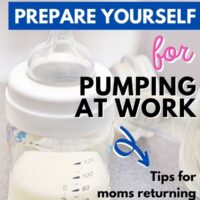This post may contain affiliate links, meaning I may earn a commission for recommending products. Read my disclosure policy for more info.
Are you a breastfeeding mom returning back to work?
The idea of pumping at work might be intimidating, but it doesn’t have to be.
If breastfeeding is going well, it’s totally possible to continue feeding your baby breast milk while working.
With a little preparation, you can pump successfully while balancing the demands of your job.
Related: How to Pump More Breast Milk
Why is it so important to pump at work?
It can be really tough to balance home and work life as a new mom.
Then, you add pumping on top of everything else– It’s a lot to juggle.
But for working mothers who are still breastfeeding, it is especially important to find time to pump breast milk during the workday.
If you don’t pump regularly then your supply will go down and that is not good for anyone!
You may also experience leakage and breast engorgement if you skip pumping, and that comes with a whole slew of its own discomforts.
Now that you know why it’s important to pump at work if you want to continue breastfeeding, let’s start getting you prepared.
These tips will help make your return to work a little less stressful!
Pumping at work: How to prepare yourself
Mentally Prepare Yourself
A huge part of preparing for pumping at work is psychologically getting yourself ready.
Knowing you have a plan in place will help relieve some anxiety about returning to work.
It may also be helpful to refresh your memory when it comes to the benefits of breastfeeding.
Reminding yourself why you decided to breastfeed your baby to start with will help you power through if you find yourself second-guessing your decision.
Stock up on pumping supplies
Before you return back to work, it’s a good idea to check this off your list now so that you won’t be scrambling to gather everything last minute.
Here’s a list of the must-haves supplies we recommend for pumping at work:
1. Breast milk storage bags or bottles
For starters, you’ll need storage bags or bottles for storing and transporting your breast milk.
2. Breast pump
You will also need a breast pump, of course.
An electric pump is a great option for pumping at work, but keep in mind that it’s still a good idea to bring a manual pump as a backup.
3. Extra breast pump parts
If you have decided to use an electric pump, do yourself a favor by going ahead and ordering some extra parts to bring to work with you.
Breast pump parts do wear out over time, so it’s a good idea to have replacements in case this happens while you’re away at work.
4. Cooler/insulated bag
Next, you will need a cooler bag for transporting your pumped milk from work to home.
Also, if for some reason your workplace doesn’t have a refrigerator (highly unlikely, but still) then the cooler bag will be useful.
Related: 8 Best Breast Milk Cooler Bags for Work and Daycare
5. Cleaning supplies
When using a breast pump, it’s recommended to clean every part that comes into contact with your breast or breast milk after each use.
A bottle brush and microwave sterilizer bags (these bags are great because they’re reusable and extremely compact) can be helpful.
If you do choose to use a microwave sterilizer bag, just be sure to check with your pump’s manufacturer to ensure this is okay to do so.
While you’re shopping for cleaning supplies, don’t forget to also toss in a couple of absorbent hand towels (burp cloths work well too), some hand sanitizer, and disinfectant wipes for quickly wiping down your space when needed.
6. Waterproof labels
Another must-have you may not have thought about– Waterproof labels.
These are great for labeling your milk storage bags or bottles with the date and time you pumped.
7. A good supply of snacks and water
Last but not least, you’ll need to be prepared with snacks and plenty of water.
Taking care of yourself will help you maintain a good milk supply!
Know the laws
According to US federal law, basic accommodations must be made for breastfeeding mothers.
Specifically, all employers must allow new mothers reasonable break times for pumping and a private place in which to do so.
These accommodations are valid until your baby’s first birthday.
Discuss your plans with your employer
Once you know what your rights are as a breastfeeding mother, it’s time to talk with your employer about your plans to pump when you return back to work.
Talking to your employer ahead of time is a good idea because it saves everyone from last-minute hassles and confusion.
It will also give them ample time to make any modifications needed to accommodate you.
When discussing your plans with your employer, be prepared for questions and concerns.
For example, you might be asked what sort of flexibility you need or your employer may wonder how often you intend to pump.
The more open you are about your plans, the better.
Invest in a breast pump (and learn how to use it)
If you’re going to be pumping regularly, then it’s imperative that you invest in a good breast pump.
It’s also important that you learn how to use the breast pump before returning back to work.
The first thing you’ll need to decide when choosing a breast pump is whether you want an electric breast pump or a manual.
This post breaks down the pros and cons of each for you if you need a refresher!
Another thing to keep in mind– Portability.
Since you will be taking your pump to and from work, a breast pump that’s fairly portable is tremendously helpful.
One other consideration– The level of noise the breast pump makes. For some moms, a noisy breast pump may not be the best option for pumping at work.
Recommendations:
If you’re looking for recommendations on a portable electric breast pump, the Spectra S1 is one option. This pump is great because it has a rechargeable battery and it runs quietly– Perfect for pumping at work!
Read more about the Spectra S1 here.
If you are considering a manual breast pump instead, we really like the Haakaa breast pumps. They are very portable, affordable, and hands-free!
Read our full Haakaa review here.
Some moms prefer to bring both an electric and a manual breast pump to work. So if the electric pump fails for any reason, they’re covered and will still be able to pump.
Choose a bottle that won’t cause nipple confusion
When you’re getting ready for pumping at work, the next step is to choose a bottle your breastfeeding baby will accept.
This can be tricky (some babies are pickier than others), so that’s why is important to start figuring this out now.
The best bottles for breastfeeding babies tend to be ones that have shorter nipples that resemble the look and feel of a natural breast.
The Nanobebe bottles and Nuk Simply Natural bottles are a couple of our favorites.
There are several great choices to choose from.
Read our full list of suggestions here.
Find a proper space for pumping at work
When you’re searching for a place to pump at work, the most important things to look for are privacy and comfort.
You’ll want a quiet and private location where you can sit comfortably in your own chair with some privacy (a locking door is great).
If you have no place in mind, this is something you can discuss when you speak with your employer about your plans to pump at work.
Make a pumping schedule
When you first start pumping at work, it’s a good idea to work out a schedule for yourself.
How often will you pump? How long will each session be?
If your baby is less than 6 months old, a good rule of thumb is to pump about every 3 hours (source).
Once your baby is eating more solids, you will be able to pump less because your baby won’t require as much breast milk.
So, your pumping schedule will depend on how many hours you’re working and your baby’s age.
Storing pumped milk at work
As we mentioned earlier, you can store your pumped milk either in breast milk storage bags or bottles.
According to the CDC, freshly pumped breast milk can be stored at room temperature for up to 4 hours– As long as it’s not warmer than 77 degrees Fahrenheit.
Since you will likely be at your job longer than 4 hours, you will need to either refrigerate your expressed milk or store it in an insulated bag/cooler.
Be sure to refrigerate or freeze (if you don’t plan on using it within 4 days) the pumped milk when you get home!
Keeping your breast pump clean at work
Every breast pump will have its own unique set of cleaning guidelines that you should familiarize yourself with.
However, there are a few basic steps to follow that will help you keep your breast pump clean.
Before pumping:
- Clean/sanitize your pumping area
- Wash your hands thoroughly with soap and warm water
- Assemble the pump and check for any mold or signs of wear
- Check tubing for any droplets of water– If you see some, run the pump for a few minutes until the tubing is dry
After pumping:
- Disassemble and wash all breast pump parts that come into direct contact with your breast/breast milk
Choosing to continue breastfeeding once you’ve returned back to work is no cakewalk, but it IS possible!
With a little planning, preparation, and proper communication at your workplace, you’ll be able to achieve your breastfeeding goals while maintaining your career.


